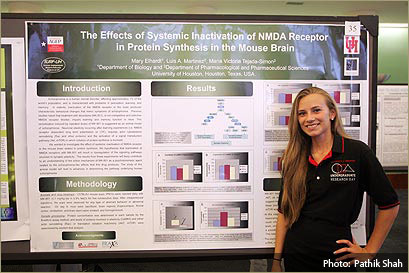
By Rolando Garcia
Natural Science and Mathematics Communications
Spending countless hours in a lab analyzing mouse brains and studying rodent behavior might not sound glamorous, but one University of Houston student's award-winning research could help scientists better understand schizophrenia.
Mary Elhardt, a senior biology major, is one of many College of Natural Sciences and Mathematics' undergraduates engaged in the sort of hands-on research typically associated with graduate students. Her research on schizophrenia-like symptoms in mice studies the effects of manipulating a particular cell receptor tied to learning and memory.
Elhardt's project took one of the top prizes last fall at an annual research poster contest showcasing UH's best undergraduate researchers. The contest featured nearly a dozen NSM student researchers.
Working under Maria Tejada-Simon, assistant professor of pharmacology at UH's College of Pharmacy, Elhardt injected mice with a drug that inhibits the NMDA receptor. The malfunction of this receptor in humans is believed to play a role in schizophrenia, a mental disorder that can cause paranoia and bizarre delusions and hallucinations.
Elhardt then tested the memory, motor skills and behavior of the mice. She found those mice with blocked NMDA receptors showed greater susceptibility to fear conditioning than a test group of mice, suggesting that blocking the receptor had induced some paranoia-like behavior, Elhardt said.
She also carefully studied the biological mechanisms at work by examining the brain tissue of the mice, where she found a decrease in protein concentration in the drugged mice.
By studying the schizophrenia-like symptoms induced in the mice by blocking the NMDA receptor, research like hers can help perfect an animal model of the disease, Elhardt said, allowing scientists to devise and test treatments for schizophrenia.
Elhardt's research required her to spend up to 20 hours a week in the lab while juggling a regular semester course load and duties as an NSM ambassador, part of an elite group of students who help with high school recruitment and other activities to represent the college.
She received financial assistance for her research from the Summer Undergraduate Research Fellowship and a Provost's Undergraduate Research Scholarship. Getting deeply involved with research as an undergraduate has been an invaluable experience, Elhardt said. "There are so many opportunities for undergraduate research here, and it really increases the value of your degree," she said. |

